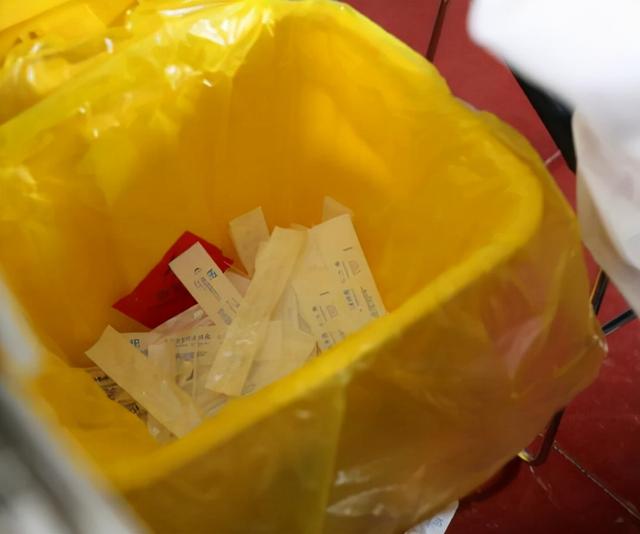병원에서 면봉 폐기물을 처리하는 방법
2024-11-06
병원에서, 면봉 표본 수집을 위한 중요한 도구입니다., 감염관리, 및 진단 테스트. 하지만, 면봉 폐기물 관리는 의료 시설이 환경 지속 가능성과 환자 안전을 모두 보장하기 위해 해결해야 하는 복잡한 문제입니다.. 면봉 및 기타 의료 폐기물 처리는 오염을 최소화하고 감염 확산을 방지하기 위해 엄격한 지침에 따라 규제됩니다.. 병원에서 면봉 폐기물을 관리하는 방법에 대한 개요는 다음과 같습니다.:
적절한 면봉 폐기의 중요성
면봉, 면봉을 포함해, 거품 면봉, 그리고 떼지어 모은 면봉, 다양한 의료 절차에 사용됩니다.. 사용 후, 그들은 종종 체액으로 오염되어 있습니다, 병원체, 또는 화학물질. 면봉 폐기물을 부적절하게 처리하면 교차 오염이 발생할 수 있습니다., 감염의 확산, 환경적 위험. 병원은 안전한 취급을 보장하기 위해 보건 당국과 환경 보호 기관이 수립한 지침을 준수해야 합니다., 처분, 그리고 이러한 물질의 재활용.
단계 1: 의료 폐기물 분류
면봉 폐기물을 관리하기 위해 병원이 취하는 첫 번째 단계 중 하나는 폐기물을 올바르게 분류하는 것입니다.. 면봉 폐기물은 다음 범주에 속합니다. “규제된 의료 폐기물” (RMW) 감염 가능성 때문에. 의료 폐기물은 일반적으로 다음 범주로 분류됩니다.:
- 감염성 폐기물: 여기에는 검체 수집이나 상처 치료에 사용되었으며 체액이나 병원균에 오염된 면봉이 포함됩니다..
- 날카로운 물건 폐기물: 면봉 자체는 날카롭지 않지만, 바늘이나 기타 날카로운 물체로 오염될 수 있으므로 그에 따라 폐기합니다..
- 비감염성 폐기물: 일부 면봉은 비감염성 물질로 오염될 수 있으며 위험하지 않은 것으로 분류됩니다..
폐기물을 올바르게 분류하여, 병원은 각 유형의 폐기물이 적절한 방식으로 처리되도록 보장합니다..
단계 2: 안전한 폐기 및 분리
면봉 폐기물이 수집되면, 색상별로 구분되어 있어요, 의료 폐기물에 대한 현지 규제 요건을 준수하는 누출 방지 용기. 대부분의 병원에서는, 3단계 폐기물 분리 시스템이 사용됩니다.:
- 빨간통: 감염성 폐기물의 경우, 바이러스나 세균 감염 테스트에 사용되는 면봉 등.
- 노란색 쓰레기통: 감염성은 없지만 주의해서 처리해야 하는 일반 의료 폐기물의 경우.
- 날카로운 용기: 사용한 바늘이나 면봉과 접촉했을 수 있는 날카로운 물체의 경우.
각 폐기물 용기는 누출을 방지하고 감염 위험을 최소화하기 위해 단단히 밀봉되어 있습니다.. 병원에서도 전문적인 장비를 활용합니다., 사용한 면봉과 기타 폐기물을 폐기 장소로 운반하기 전에 담는 생물학적 위험 봉투.
단계 3: 처리 및 폐기 방법
면봉 폐기물은 일반적으로 소독 및 처리되어 감염원이 없음을 확인합니다.. 의료 폐기물을 처리하는 두 가지 주요 방법은 다음과 같습니다.:
- 고압멸균: 감염성 폐기물을 처리하는 가장 일반적인 방법, 오토클레이빙은 압력을 가한 증기를 사용하여 폐기물을 멸균하는 것입니다.. 높은 열로 인해 면봉에 있는 모든 병원균이 최종 폐기를 위해 보내지기 전에 파괴됩니다..
- 소각: 일부 경우에, 의료폐기물은 유해미생물을 완전히 사멸시키기 위해 고온에서 소각 처리됩니다.. 이 방법은 고압멸균할 수 없는 폐기물에 특히 효과적입니다..
살균 후, 처리된 폐기물은 매립 또는 재활용 시설로 보내집니다., 폐기물의 성격에 따라. 병원은 점점 더 환경 친화적인 관행을 채택하고 있습니다., 예를 들어, 그들이 생성하는 재활용이 불가능한 폐기물의 양을 줄이는 것, 일부 면봉은 멸균 후 재활용 가능.
단계 4: 재활용 및 지속 가능성
최근 몇 년 동안, 많은 병원이 보다 지속 가능한 폐기물 관리 관행으로 전환했습니다., 특정 의료 품목의 재활용 및 재처리 포함. 면봉 자체는 오염으로 인해 재활용이 불가능할 수 있지만, 면봉 폐기물과 관련된 일부 물질, 포장, 플라스틱 부품 등, 재활용이 가능하다. 병원은 환경에 미치는 영향을 줄이기 위해 폐기물 에너지 기술과 지속 가능한 폐기 옵션에 투자하고 있습니다..
추가적으로, 의료 제조업체 재활용이 불가능한 폐기물 발생량을 줄이기 위해 생분해성 또는 친환경 소재를 사용하여 면봉 및 기타 소모품을 생산하고 있습니다.. 병원은 또한 재고 관리를 최적화하고 일회용 면봉의 불필요한 사용을 줄여 환경에 미치는 영향을 줄일 수 있습니다..
단계 5: 직원 교육 및 규정 준수
효과적인 폐기물 관리는 잘 훈련된 의료진으로부터 시작됩니다. 병원은 의료 폐기물 처리 및 처리와 관련된 모든 직원에게 교육을 제공합니다., 안전 프로토콜과 적절한 폐기물 분리의 중요성을 이해하도록 보장. 병원도 현지 규정을 준수합니다., 상태, 전염병 노출 및 환경 오염 위험을 최소화하기 위한 국가 규정.
결론
병원은 공중 보건과 환경을 모두 보호하기 위해 면봉 폐기물을 신중하게 관리해야 합니다.. 분류를 위한 엄격한 프로토콜을 따름으로써, 처분하다, 의료폐기물 처리, 의료 시설에서는 면봉 폐기와 관련된 위험을 최소화합니다.. 병원이 계속해서 지속가능성을 수용함에 따라, 폐기물 관리 관행은 의료 요구와 환경 목표를 모두 충족하도록 발전할 것입니다..

















